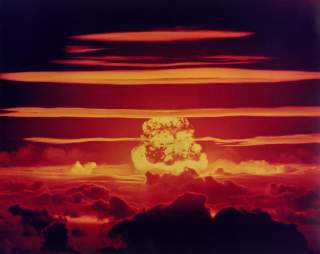North Korea Might Just Blow Up a Nuclear Weapon in the Atmosphere
And it could spark a crisis like no other.
As North Korea’s nuclear and ballistic missile programs have become more adventurous, a worrying possibility has begun to emerge. There’s a chance that—at some point—the North Koreans might want to combine the two testing programs, by putting a live nuclear warhead on top of a ballistic missile. That means, assuming all goes as it should, the missile would fly downrange to its appointed target zone, and the warhead would detonate in the atmosphere. That sort of test—an end-to-end test of the full weapon system—would be a convincing demonstration that Pyongyang had crossed the critical bridges: that it had a long-range ballistic missile with the throw-weight to carry a nuclear warhead, a warhead able to be placed atop the missile, and a re-entry vehicle that could survive the stresses of re-entry.
It would also be dangerous. A lot can go wrong during a ballistic missile test. When things do go wrong, missile controllers usually order the missile to self-destruct. But most missile tests don’t involve live nuclear warheads. Besides, in the early stages of a missile’s development, testing is primarily about learning the limitations and vulnerabilities of the particular weapon system. Becoming familiar with a ballistic missile typically involves a number of launches—and God knows North Korea does few enough of those as it is. Remember the Hwasong-12, Pyongyang’s intermediate-range ballistic missile? It’s been tested three times. The Hwasong-14 ICBM? That was tested twice, both times on lofted trajectories. The latest missile, the Hwasong-15, has been test-fired only once—again, on a lofted trajectory.
Recommended: This Video Shows What Happens if Washington, D.C. Is Attacked with Nuclear Weapons
Recommended: 8 Million People Could Die in a War with North Korea
Recommended: Why North Korea Is Destined to Test More ICBMs and Nuclear Weapons
Well, you might think, surely they have older, better-tested missiles somewhere in their arsenal. Sure they do, but those are generally short- and medium-range missiles—which aren’t of much use if the point is to lob a warhead somewhere out into the distant reaches of the Pacific Ocean. Putting a live nuclear warhead on a missile that wouldn’t clear Japan isn’t an option. But putting one on an under-proven longer-range delivery vehicle doesn’t sound like a smart move either. Still, Pyongyang might be tempted down that path in order to demonstrate the ‘completion’ of its programs.
Such tests have been done before by other nuclear-weapon states. True, they’re incredibly rare, and no such test has been conducted since the 1960s. In 1962, the US conducted a nuclear test involving an operational submarine-launched ballistic missile. The test, code-named ‘Frigate Bird’, was held on 6 May. It was ‘the only US test of an operational ballistic missile with a live warhead’. It involved the launch of a Polaris A1 SLBM from the submarine USS Ethan Allen, a missile flight of about 1,000 nautical miles, and the atmospheric detonation of a 600-kiloton nuclear warhead in the vicinity of Christmas Island. (Let me hasten to assure Australian readers that the ‘Christmas Island’ in question was in the Line Islands in Kiribati, and not off the northwest coast of Australia.)
Although the details are sketchy, the Russians seem to have done something similar in Test 95, conducted on 13 September 1961. An SLBM launched from the Barents Sea flew to the test range on Novaya Zemlya. As a safety measure, the Russians seem to have deliberately replaced the missile’s usual warhead with one of reduced yield, since the resulting nuclear detonation was about 6 kilotons. Some sources suggest there might have been other such tests as well, though it’s important to count only those that actually involved ballistic missiles, rather than other weapon systems.
In October 1966, the Chinese conducted a nuclear test involving the ballistic-missile delivery of the warhead to their Lop Nur test site. This test was CHIC-4, held on 27 October. The missile was a CSS-1 medium-range missile, which flew about 900 kilometres before the warhead—a simple fission design with a yield of approximately 12 kilotons—was detonated in the atmosphere. CHIC-3 had a yield of 250 kilotons, and CHIC-5 300 kilotons, so it’s reasonable to conclude that the Chinese also made an effort to dial back the CHIC-4 yield as a safety precaution. (As a point of interest, the CHIC-4 design—labelled ‘early, [and] inefficient’ by the CIA—is the one the Chinese later shared with the Pakistanis.)
Given that the US and Russia have both conducted end-to-end tests by using SLBMs, Kim Jong-un might be drawn to pursue a similar option. An SLBM needn’t involve overflight of Japan. And it would allow the test to be conducted remote from major urban areas. But that assumes, of course, that Kim has a working SLBM, not to mention a submarine capable of launching it—which he probably doesn’t at this point in time. What Kim has is an under-tested ICBM capability, plus of course an under-tested intermediate-range ballistic missile capability. If he decides to try for an end-to-end nuclear test with one of those, we might be in trouble.
None of the previous tests by the US, Russia and China, remember, have involved an intercontinental-range or even an intermediate-range missile. Any scenario in which Pyongyang attempts such a test—humorously labelled ‘Juche Bird’ by some—is fraught with danger. Indeed, even the preparations for such a test, including the loading of a nuclear warhead onto a long-range missile, might well trigger a US pre-emptive strike. After all, how could a US president be confident that a nuclear-tipped ICBM was being launched only for testing purposes?
This first appeared in ASPI's The Strategist here.

